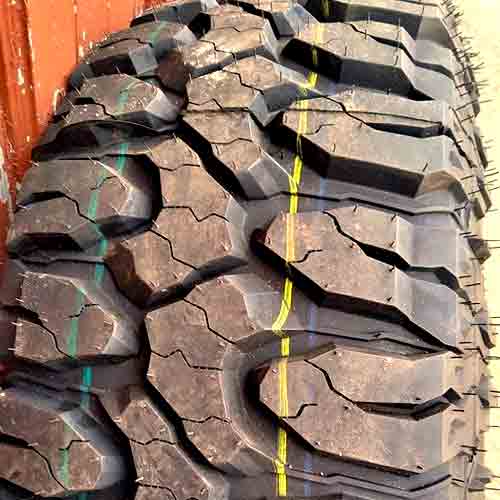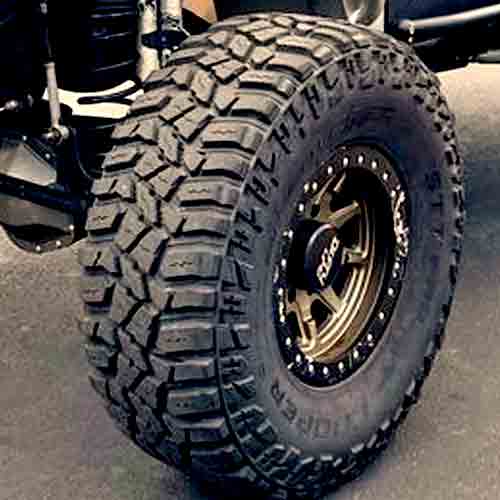Both the Milestar Patagonia MT and the Cooper STT Pro are powerful mud-terrain (M/T) tires, made for raw commercial traction. But which one is for you? Let’s find out!

My overall testing with these tires tell me that the Milestar M/T features a superior wet grip, and comfort performance with it’s softer compound. Though it’s also surprisingly better in the fuel department as well. The Cooper STT Pro on the other is greater when it comes to mud and rocky terrains, and on road is offers superior dry grip and a bit more quieter ride.
Choosing the Right Tire Size
The Milestar Patagonia MT offers15 to 22 inches rim diameters with following specs:
- Speed ratings: Q on all.
- Load ratings: C to F.
- Weight range: 50 to 88 lbs
- Tread depth: 18 and 19/32″.
- Ratings: No 3PSMF.
- Warranty: None.
(These also include 3 “black labelled” sizes as well, and these include, 37X12.50R17LT, 38X13.50R17LT and 40X13.50R17).
On the other side, the Cooper Discoverer STT Pro offers 49 total sizes in 15″ to 22″ rim sizes, coming with following specs.
- Speed rating of Q.
- Load Ratings: C to F.
- Weight Range: 42 to 94 lbs.
- Tread Depth Range: 18 to 22/32.
Tread Styles and Features
Milestar Patagonia MT is a unique looking tire, so let me discuss this one first.

What makes Patagonia MT so unique is its single rib design in the middle. You would not see too many mud-terrain tires with such designs.
And this rib is pretty well engineered too, as it gets to offer both lateral and directional stability on-roads, and at the same time off-road traction as well.
With U shaped lugs packed up closely to each other, they supply directional traction on highways, and as they wrap around the shoulder lugs as well, they aid in lateral grip that way too.
And with sharp edges, chamfered sides and full depth sipes, you also get the needed biter on all kinds of rugged terrains.
The shoulder lugs also have dual functionality. They offer powerful biters, and staggered outer margin with mud scoops, which help off-road.
And where the sidewall lugs further aids that traction (with lowered air pressure mostly), you also get stability as these lugs are made by joining up the shoulder blocks.
On the other hand, the Cooper STT Pro features a slightly more aggressive tread design.

In the middle, the tire is although seen with a single rib, just like the Milestar, it contains more blocks, comparatively.
Each block has more (off-set) edges to them, along with interlocking sipes. And together they form a very self cleaning channels.
In fact, the tire has more of a lateral orientation of its grooves, rather than longitudinal.
It’s central lugs look like they are split up from the shoulders.
Speaking of which, the shoulder blocks are elongated and have very biting structure to them as well. They are 2 unique blocks. One forms deep in-groove biters, and has snow vices on edges, and the other is seen with similar features, common to central lugs.
Moreover, these blocks are staggered and join up on sidewalls.
Navigating Wet Roads
Achieving wet traction in tires relies on effective water removal, which entails both hydroplaning resistance and grip. It’s the most challenging for mud tires.
Let’s discuss these factors one by one.
Wet Grip
Wet grip requires flexible/soft enough tread, and abundant siping.
Although mud tires often offer numerous grooves for water evacuation, they typically lack sufficient siping (as it causes wear, and they need durability too, of course).
But the good news here is that both of these tires feature more siping slits, on average (compared to other options).
Despite this, the Cooper STT Pro still falls short in comparison. This can be attributed to its harder tread compound, which inhibits the sipes from properly absorbing water particles within their slits (this is how sipes function—they create suction, by expanding, soaking up water).
In contrast, the Milestar Patagonia MT presents an optimal combination of siping and pliability, resulting in better wet grip performance. However, it falls short in terms of hydroplaning resistance.
Hydroplaning
Hydroplaning, or aquaplaning, occurs when a tire fails to efficiently remove water from its tread, causing it to float on the surface.
And let me tell you, here speed is a significant factor, as higher speeds demand faster water evacuation. This is why float speeds are used to measure hydroplaning performance.
Having said that, while both tires have similar straight float speeds, the Milestar Patagonia MT underperforms in curved aquaplaning tests.
This is because, its closed central rib impedes efficient water evacuation through the sides, limiting its resistance to aqua or hydroplaning.
Winter Traction
Mud-terrain tires are basically made very self cleaning (from their tread) and this although is great for traction on mud, its not so much for snowy terrains.
Basically snow to snow contact is preferred, as this yields superior friction. That’s why tires with greater snow grabbing/holding capabilities get to have 3 peak mountain snowflake ratings, unlike the mud-tires (I haven’t seen any MT with this rating, if you find one, let me know in the comments).
But yes, mud tires do offer scooping with their huge lugs, forming multiple-angles grooves, paddling their way out. Though that only goes for deeper terrains.
And in that scenario, the Cooper Discoverer STT Pro has the upper hand.
It’s lugs are laterally oriented. Meaning its elongated shoulders and lugs in the middle, both form sideways facing grooves, connecting both edges of the tread.
So they paddle though the snow with much more efficiency.
Highway Performance
On dry pavements there are 3 main dimensions, dry grip, handling and steering feedback. Let’s talk about them all.
Dry Grip
Dry grip is actually directional, that’s why it’s calculated with the help of stopping abilities (which is only done while moving straight).
Furthermore, it also depends on the central part of the tire’s tread, as it stays more connected with the surface (while rolling).
And considering that, it makes sense why the Milestar M/T comes out with shorter braking distances (upon testing), with it’s (almost) continuous running central rib with C shaped lugs in them.
The Cooper STT Pro on the other hand, has lateral orientation of lugs (as explained in the tread section), so its get to face a harder time staying as connected with the road, as its counterpart.
Dry Handling
When the tire corners, most of the tire’s weight emphasis is on the shoulders, so here although the Cooper STT Pro comes with relatively smaller shoulders, they still offer a greater lateral traction.
This is because of two things.
One the tire has laterally arranged lugs, so they offer better weight distribution to the blocks while cornering.
And second, it comes with a stiffer rubber composition, and those supply better steering response.
Fuel Efficiency
The more the rolling resistance, the larger the fuel consumption. And that performance metric gets directly affected by the tires weight.
And so by weighing less, (across all sizes, on average), the Milestar Patagonia MT is able to produce lower rolling resistance values.
Because of its closed up lugs arrangement (in comparison), its weight is put upon greater lugs area. So with less pressure on them, the tire gets to consume less fuel as a result.
Tread Life
The tire’s tread life is high dependent on weight and rubber compound its made out of, so it makes sense why MTs don’t last as much as less aggressive tires having harder rubber and lighter structures.
Though still here the Cooper Discoverer STT Pro takes the upper hand, even with it’s higher rolling resistance values. Why you ask?
Well, because of 2 things, it’s harder rubber which is less prone to burn off as quickly, and it’s comparatively greater tread depth, which takes longer to come down to tread depth where its time to change the tires.
The opposite happens on Milestar Patagonia MT.
Comfort and Smoothness
Two crucial components that contribute to the quality of a ride are the noise generated by the tire tread and tires effectiveness to reduce road imperfections.
I’ll discuss each of these in more detail.
Tread Noise
On highways, tire noise results from various factors, including rolling friciton, air impact on grooves, and resonance from the tread’s composition, among others. Yet the primary goal is to minimize tire noise, of course.
In the case of the Cooper Discoverer STT Pro, its relatively balder structure allows for greater air movement, causing air particles to collide with the grooves and generate groove resonance, leading to louder tread noise.
On the other hand, the Milestar M/T is quieter due to its superior pitch sequencing, also known as variable pitch technology (although its a term Nitto uses).
This design incorporates slightly different shapes in the tread blocks, causing air to create diverse tones and frequencies upon impact.
These varying tones and frequencies attempt to cancel each other out, effectively reducing overall tire noise.
Road Impact
Both of these boys being a mud terrain tires would not be as comfortable as say all-terrain tires of course, with such wider tread voids, reducing overall maneuvering stability. Some tires are still above average.
And Milestar M/T is in that list. The tire offers a very spongier compound, that easily settles way more vibrations in its tread compared to its counterpart.
The Cooper STT Pro on the other hand, is way more stiff, so it can’t dampen down the imperfections of the road as better.
Rugged Terrain Traction
For off-road adventures, you need tires with exceptional cleaning capabilities and durability, allowing you to confidently navigate various terrains. Let’s evaluate each of these lands below.
Navigating Muddy Surfaces
Both tires are premium options for handling muddy conditions, yet the Cooper STT Pro has a slight advantage.
Its laterally-oriented lugs effectively clear the tire’s path, flinging mud backward with ease and generating forward momentum.
Conversely, the Milestar M/T’s performance is hindered by its continuous, tightly-packed central rib, which restricts mud flow and limits evacuation capabilities, resulting in subpar overall muddy terrain performance.
Rock Crawling
A tire designed for rocky terrains should have a flexible and pliant tread with blocks that can bend to enhance grip from multiple angles.
In addition to that, these tires must also have durable sidewalls that guard against sharp rocks and punctures, along with thick lugs on top for “sidewall flexing”.
Though one might assume the Milestar M/T, with its pliable lugs, would be superior here, the Cooper STT Pro is equally impressive and ranks among the top mud tires for rocky surfaces.
Its durability is enhanced by its stiffer cut-resistant rubber, and its combination of lateral and longitudinal tread voids render grip in all directions.
These features aren’t as great on Milestar M/T lacks.
On Sand
To maintain traction on sand, it’s crucial to minimize digging. And the tire’s weight and sharp shoulders (on tread) can work against this goal.
While both tires are similar in weight (well almost, on average), the Milestar Patagonia MT’s softer compound and wider lugs offer better overall performance.
Its sidewall lugs basically spread out more, and that provides a larger footprint connecting with the sand, promoting flotation.
On the other hand, although the Cooper STT Pro’s laterally-oriented lugs paddle effectively across soft sand, its sharper and stiffer edges, combined with biting sidewalls, prevent it from floating as well as its counterpart.
Conclusion
Given the substantial research behind the information above, it’s highly encouraged to review it in its entirety. However, for those with time constraints, I’ll provide a condensed overview of the key points.
The Milestar Patagonia MT showcases exceptional prowess in the following performance categories.
- Sand grip.
- Wet grip.
- Impact comfort.
- Fuel economy
On the other hand, the Cooper Discoverer STT Pro
- Grip on rocks.
- Mud performance.
- Tread life.
- Tread noise.
- Snow traction.
- Dry grip.